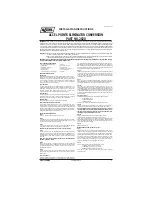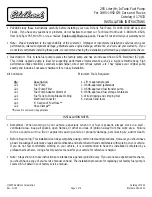
In situations where Autosteer is temporarily unavailable,
the Autosteer icon disappears. For example, your driving
speed is not within the speed required for Autosteer to
operate. Autosteer may also be unavailable if it is not
receiving adequate data from the camera(s).
If unable to detect lane markings, Autosteer may
determine the driving lane based on a vehicle you are
following.
In most cases, Autosteer attempts to center Model X in
the driving lane. However, there may be situations in
which Autosteer may steer Model X in a driving path
that is offset from the center of the lane (for example,
detection of guard rails).
WARNING:
Autosteer is not designed to, and will
not, steer Model X around objects partially in a
driving lane and in some cases, may not stop for
objects that are completely blocking the driving
lane. Always watch the road in front of you and
stay prepared to take immediate action. It is the
driver's responsibility to be in control of Model X at
all times.
Restricted Speed
On a controlled-access highway, the cruising speed
reflects the speed limit, taking into consideration any
offset you've specified using Speed Assist. However, if
you choose to use Autosteer on residential roads, a road
without a center divider, or a road where access is not
limited, Autosteer may limit the maximum allowed
cruising speed and the instrument panel displays a
message indicating that speed is restricted. The
restricted speed will be the speed limit of the road plus
10 km/h.
In situations where the speed limit cannot be detected
when Autosteer is engaged, Autosteer reduces your
driving speed and limits the set cruising speed to 70
km/h. Although you can manually accelerate to exceed
the limited speed, Model X may not brake for detected
obstacles. Autosteer slows down to the limited speed
when you release the accelerator pedal. When you leave
the road, or disengage Autosteer by using the steering
wheel, you can increase your set speed again, if desired.
Hold
Steering Wheel
Autosteer determines how best to assist in steering
Model X. When active, Autosteer requires you to hold
the steering wheel. If it does not detect your hands on
the steering wheel for a period of time, a flashing light
appears along the top of the instrument panel and the
following message displays:
Apply slight turning force to steering
wheel
Autosteer detects your hands by recognizing slight
resistance as the steering wheel turns, or from you
manually turning the steering wheel very lightly (without
enough force to take over steering).
NOTE:
When your hands are detected, the message
disappears and Autosteer resumes normal operation.
Autosteer requires that you pay attention to your
surroundings and remain prepared to take control at any
time. If Autosteer still does not detect your hands on the
steering wheel, the flashing light on the instrument panel
increases in frequency and a chime sounds.
If you repeatedly ignore Autosteer's prompts to apply
slight force to the steering wheel, Autosteer disables for
the rest of the drive and displays the following message
requesting you to drive manually. If you don't resume
manual steering, Autosteer sounds a continuous chime,
turns on the warning flashers, and slows the vehicle to a
complete stop.
Autosteer unavailable for the rest of this
drive. Hold steering wheel to drive
manually.
For the rest of the drive, you must steer manually.
Autosteer is available again on your next drive (after you
stop and shift Model X into Park).
Autosteer is Aborting
In situations where Autosteer is unable to assist in
steering Model X, Autosteer aborts, sounds a warning
chime, and displays the following message on the
instrument panel:
Autosteer is aborting
Canceling Autosteer
Autosteer cancels when:
• You press the brake pedal.
• You apply rotational force to the steering wheel (even
a slight amount).
• You push the Autopilot stalk away from you.
• You exceed the maximum speed at which Autosteer
operates – 150 km/h.
• You shift.
• A door is opened.
Autosteer
109
Autopilot
















































